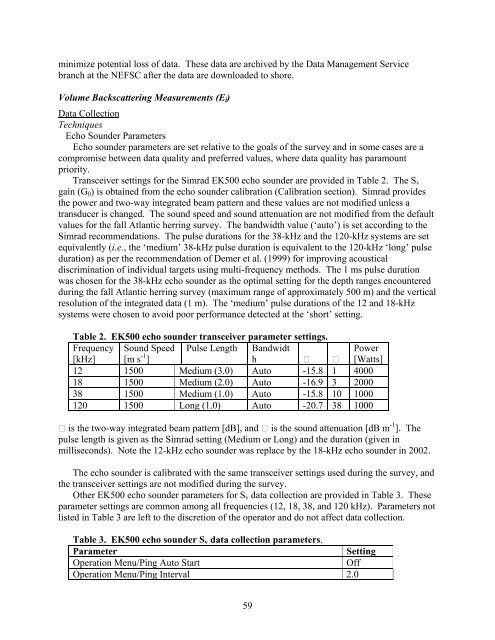NOAA Protocols for Fisheries Acoustics Surveys and Related ...
NOAA Protocols for Fisheries Acoustics Surveys and Related ...
NOAA Protocols for Fisheries Acoustics Surveys and Related ...
You also want an ePaper? Increase the reach of your titles
YUMPU automatically turns print PDFs into web optimized ePapers that Google loves.
minimize potential loss of data. These data are archived by the Data Management Service<br />
branch at the NEFSC after the data are downloaded to shore.<br />
Volume Backscattering Measurements (E i )<br />
Data Collection<br />
Techniques<br />
Echo Sounder Parameters<br />
Echo sounder parameters are set relative to the goals of the survey <strong>and</strong> in some cases are a<br />
compromise between data quality <strong>and</strong> preferred values, where data quality has paramount<br />
priority.<br />
Transceiver settings <strong>for</strong> the Simrad EK500 echo sounder are provided in Table 2. The S v<br />
gain (G 0 ) is obtained from the echo sounder calibration (Calibration section). Simrad provides<br />
the power <strong>and</strong> two-way integrated beam pattern <strong>and</strong> these values are not modified unless a<br />
transducer is changed. The sound speed <strong>and</strong> sound attenuation are not modified from the default<br />
values <strong>for</strong> the fall Atlantic herring survey. The b<strong>and</strong>width value (‘auto’) is set according to the<br />
Simrad recommendations. The pulse durations <strong>for</strong> the 38-kHz <strong>and</strong> the 120-kHz systems are set<br />
equivalently (i.e., the ‘medium’ 38-kHz pulse duration is equivalent to the 120-kHz ‘long’ pulse<br />
duration) as per the recommendation of Demer et al. (1999) <strong>for</strong> improving acoustical<br />
discrimination of individual targets using multi-frequency methods. The 1 ms pulse duration<br />
was chosen <strong>for</strong> the 38-kHz echo sounder as the optimal setting <strong>for</strong> the depth ranges encountered<br />
during the fall Atlantic herring survey (maximum range of approximately 500 m) <strong>and</strong> the vertical<br />
resolution of the integrated data (1 m). The ‘medium’ pulse durations of the 12 <strong>and</strong> 18-kHz<br />
systems were chosen to avoid poor per<strong>for</strong>mance detected at the ‘short’ setting.<br />
Table 2. EK500 echo sounder transceiver parameter settings.<br />
Frequency Sound Speed Pulse Length B<strong>and</strong>widt<br />
Power<br />
[kHz] [m s -1 ]<br />
h [Watts]<br />
12 1500 Medium (3.0) Auto -15.8 1 4000<br />
18 1500 Medium (2.0) Auto -16.9 3 2000<br />
38 1500 Medium (1.0) Auto -15.8 10 1000<br />
120 1500 Long (1.0) Auto -20.7 38 1000<br />
is the two-way integrated beam pattern [dB], <strong>and</strong> is the sound attenuation [dB m -1 ]. The<br />
pulse length is given as the Simrad setting (Medium or Long) <strong>and</strong> the duration (given in<br />
milliseconds). Note the 12-kHz echo sounder was replace by the 18-kHz echo sounder in 2002.<br />
The echo sounder is calibrated with the same transceiver settings used during the survey, <strong>and</strong><br />
the transceiver settings are not modified during the survey.<br />
Other EK500 echo sounder parameters <strong>for</strong> S v data collection are provided in Table 3. These<br />
parameter settings are common among all frequencies (12, 18, 38, <strong>and</strong> 120 kHz). Parameters not<br />
listed in Table 3 are left to the discretion of the operator <strong>and</strong> do not affect data collection.<br />
Table 3. EK500 echo sounder S v data collection parameters.<br />
Parameter<br />
Setting<br />
Operation Menu/Ping Auto Start<br />
Off<br />
Operation Menu/Ping Interval 2.0<br />
59
















